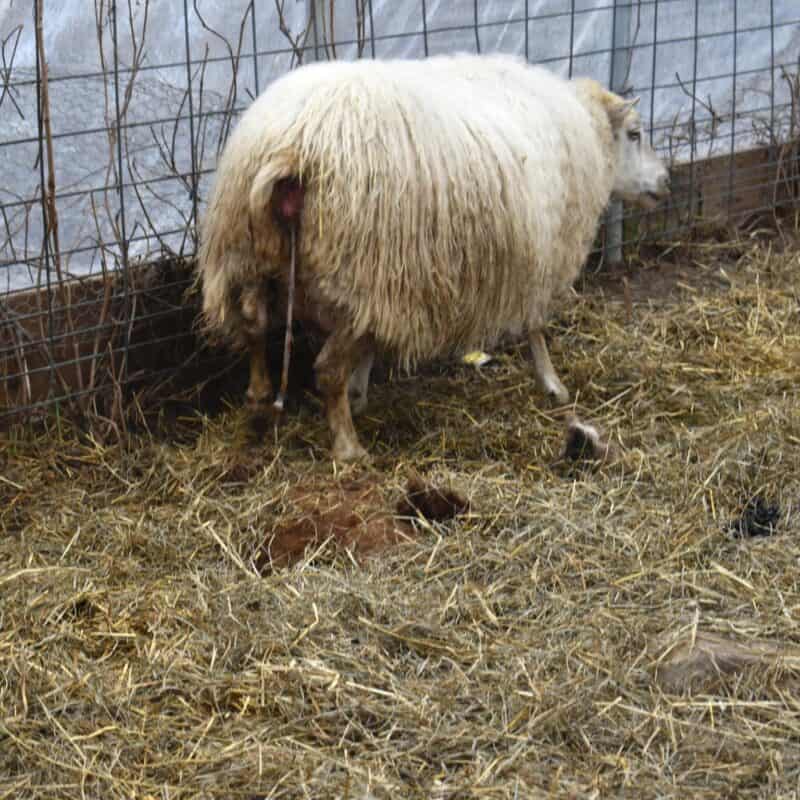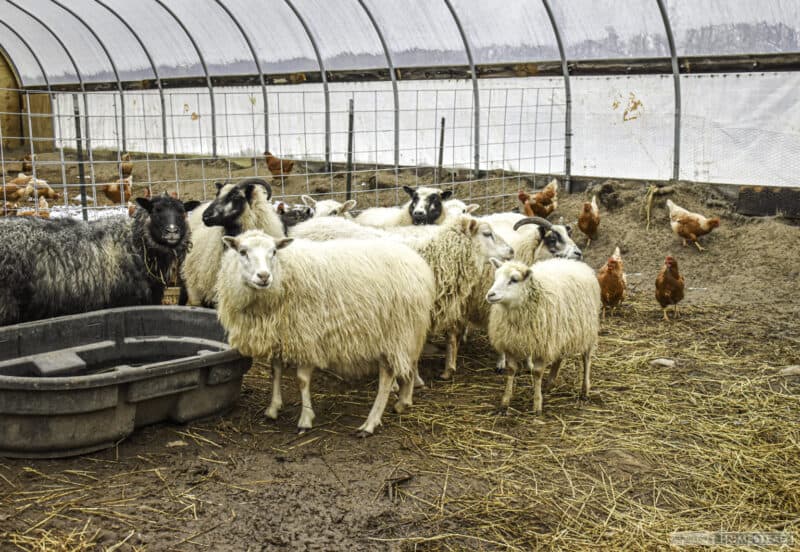One of the most exciting times on any homestead is when one of your animals is due to deliver a baby. And it always means there’s going to be a lot to do, but the joy and wonder associated with a new addition to your flock or herd is always a special time.

But in the case of sheep particularly, it is hardly uncommon to learn that they have delivered their precious little lamb out in a field somewhere- and when you were least expecting it!
It’s better if you know that it is coming so you can make preparations. So, how can you tell when a sheep is close to lambing?
Ewes give several indications when they are close to delivering, including:
- ✅ a substantially fuller udder,
- ✅ rapidly firming teats,
- ✅ obvious nesting behavior,
- ✅ a sunken abdomen,
- ✅ restless behavior,
- ✅ a reddening of the vulva,
- ✅ the refusal of food,
- ✅ and the passing of one or more water bags.
Some of these indicators are subtler than others, but many are incredibly conspicuous and happen immediately before delivery.
Once you know what to look for, you can get into a rhythm where you can set your sheep up for success prior to the arrival of her baby. I’ll tell you a lot more about each of these indicators in the rest of this article…
A Full Udder
Assuming you know your sheep is pregnant in the first place (the gestation period being around 5 months on average), the very first thing you should be on the lookout for is the filling of her udder.
Typically around a month prior to delivery, and sometimes a bit earlier or a bit later, her owner will grow dramatically in size and take on an obviously plump appearance.
As a rule of thumb, the farther along she gets, the bigger and the firmer that her udder will get.
But once you notice it (and you should if you’re paying attention to your sheep) you can put a pin on your calendar, so to say, because you know you’ll have about a month to go, or maybe three weeks.
Teats Firming Up
Associated with the filling of the other, but happening much closer to delivery is the firming up of the individual teats.
Note that if you don’t have a lot of experience with sheep generally and pregnant sheep specifically, you might not know exactly what to look for or how it feels.
One way to find out is to just go hands-on with your ewe. Once you notice her udder filling up, give her teats a squeeze.
Then do the same thing when she’s much closer to delivery, especially if you can gauge it to be about 7 to 10 days out.
In the future, you won’t forget the difference and whenever you notice this change in the teats you’ll know that she doesn’t have much farther to go.

Sunken Abdomen
One of the first near indicators for delivery that you’ll see is a sunken abdomen. This occurs because the little lamb inside its mother drops into a lower position inside her body in order to facilitate delivery.
When you notice that plump, firm area of her flanks suddenly disappears and there is now a notable dip between her hindmost rib and her hips, you’ll know the lamb has “dropped.”
If you haven’t already, make preparations for immediate delivery because the cute little thing will only be a couple of days out at most by this point.
Nesting Behavior
Nesting behavior is a variable indicator of delivery, not the least of which because some sheep are a lot more assertive and interested in nesting whereas others are much less so.
Similarly, some moms wait till the very last minute while others start making preparations as much as a week in advance.
In all cases, however, you’ll notice the ewe moving away from the rest of the flock and starting to paw at the ground or occasionally creating a depression or piling up grass and hay in order to make a soft, safe and warm place to give birth.
Ideally, before this point, when you know the sheep is close, you will sequester her in a pen or paddock that she has all to herself so she can nest comfortably without stress (and also so you won’t have to track her down when she does give birth).
Pacing or Restless Behavior
Cheap tend to be lazy, and accordingly anything that gets in the way of them being lazy and relaxing is usually an indicator that something is wrong or changing.
It’s no different with pregnancy, and a ewe will become incredibly uncomfortable and restless as delivery draws near.
Watch for strange behavior to increase as she gets closer to lambing: Early indicators include leaning, circling or trying to prop up her front legs on a fence or other obstacle.
And especially if she seems like she cannot get comfortable when sitting or laying down, or if you notice her getting up and lying down repeatedly, you’ll know she is very close!
It might be alarming to see your sheep acting so strange, but again, it’s a normal part of pregnancy…
Reddening Vulva
Not too long before delivery a sheep’s reproductive parts, her vulva, will start to turn pink and then eventually red thanks to significantly increased blood flow to this part of her body ahead of labor and delivery.
This is another indicator of delivery that is very easy to spot, but if your sheep has a tail you’ll have to look closely or lift the tail in order to see. In any case, assuming you know your sheep is pregnant this is a highly reliable indicator of labor.
Keep in mind that in other circumstances a red vulva might indicate problems much earlier in pregnancy, or infection or injury in any sheep that isn’t with lamb.
Refusing Food
Although it’s alarming, it is entirely normal for a ewe to skip meals or refuse food entirely during pregnancy.
Skipping a meal every once in a while is normal during pregnancy when she is about midway through, and is nothing to worry about so long as she’s getting plenty of nutrition on the usual schedule.
But you should be on the lookout for a sudden cessation in eating because that usually indicates that the lamb is due that very same day, or the morning following. In fact, a total loss of appetite might technically be considered the very first indicator of labor.
But when you notice this behavior, you must keep a near-constant watch on the sheep in question: if the lamb does not come along very shortly thereafter and your sheep does not resume eating you must contact your vet right away.
In such cases, it’s an indicator of major problems with the pregnancy or in the aftermath of delivery (toxemia). It can potentially mean the death of the mother if she doesn’t resume eating!
Dropping Water Bags
Sheep break water just like people do immediately prior to delivery. Actually, they might not necessarily “break” water because sometimes the bag of water, really amniotic fluid, might pop out of her and stay intact!
Looking for all the world like a grisly balloon, it is definitely unsettling when you see it for the first time but it’s nothing to worry about and totally normal, I promise!
But most importantly, if you see this you know that the lamb is about to greet the world in a matter of minutes, usually no longer than half an hour.
In fact, if you’re going to make preparations and try to get your sheep into a paddock or other enclosure for delivery, it might be too late.
Also, keep in mind that these sacks of fluid can be different colors and it doesn’t mean that anything is wrong with the mother or baby!
Tom has lived and worked on farms and homesteads from the Carolinas to Kentucky and beyond. He is passionate about helping people prepare for tough times by embracing lifestyles of self-sufficiency.
